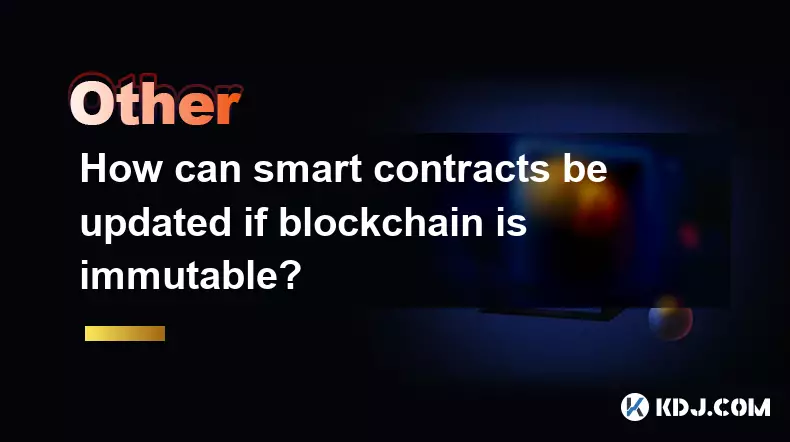-
 bitcoin
bitcoin $99296.318777 USD
-2.82% -
 ethereum
ethereum $3203.465899 USD
-6.84% -
 tether
tether $0.999590 USD
-0.03% -
 xrp
xrp $2.308913 USD
-4.00% -
 bnb
bnb $922.788929 USD
-3.53% -
 solana
solana $144.020807 USD
-5.89% -
 usd-coin
usd-coin $0.999798 USD
0.00% -
 tron
tron $0.291590 USD
-1.12% -
 dogecoin
dogecoin $0.163780 USD
-4.46% -
 cardano
cardano $0.526919 USD
-4.40% -
 hyperliquid
hyperliquid $37.888865 USD
-2.24% -
 bitcoin-cash
bitcoin-cash $510.515457 USD
-1.08% -
 chainlink
chainlink $14.436987 USD
-5.63% -
 stellar
stellar $0.267345 USD
-4.77% -
 unus-sed-leo
unus-sed-leo $9.175222 USD
0.53%
How can smart contracts be updated if blockchain is immutable?
Smart contracts can be upgraded without breaking blockchain immutability by using proxy patterns that redirect logic to new implementations while preserving data and address.
Nov 09, 2025 at 09:20 pm

Understanding the Paradox of Immutable Blockchains and Smart Contract Updates
1. Blockchain technology is built on the principle of immutability, meaning once data is written to the blockchain, it cannot be altered or deleted. This characteristic ensures transparency, security, and trust in decentralized systems. However, smart contracts—self-executing programs that run on blockchains—are often expected to evolve as bugs are discovered or features need improvement. The contradiction between immutability and the need for updates presents a unique challenge.
2. Developers have devised architectural patterns and mechanisms to allow smart contract logic to be upgraded without violating the integrity of the blockchain. These methods do not change the original code but instead redirect execution to new implementations while preserving the state and address of the contract.
3. One common approach involves using proxy patterns, where a proxy contract holds the state and acts as an interface, while the actual logic resides in a separate, upgradeable implementation contract. By changing the reference to the implementation, developers can effectively update functionality.
4. Another strategy is contract migration, where a new version of a smart contract is deployed, and users are instructed or incentivized to move their assets and interactions to the updated contract. This method maintains immutability by leaving the old contract untouched while shifting activity to a new one.
5. Some blockchain platforms, such as Ethereum, support standards like ERC-1967, which define secure ways to implement upgradeable contracts. These standards help ensure that upgrades are transparent and verifiable, reducing risks associated with malicious changes.
Proxy Patterns: The Core Mechanism Behind Upgradable Contracts
1. The most widely adopted solution for updating smart contracts is the proxy pattern. In this setup, two contracts are involved: a proxy contract and an implementation contract. The proxy stores all critical data and forwards function calls to the implementation via delegatecall.
2. When an update is needed, developers deploy a new implementation contract and update the pointer in the proxy to reference the new address. This allows the logic to change while keeping the same contract address and stored data.
3. There are several variations of the proxy pattern, including the Transparent Proxy, UUPS (Universal Upgradeable Proxy Standard), and Diamond Pattern. Each offers different trade-offs in terms of gas cost, control, and complexity.
4. In a Transparent Proxy, a designated admin address has exclusive rights to upgrade the implementation, while regular users interact with the contract without noticing any difference. This separation helps prevent unauthorized upgrades.
5. UUPS moves the upgrade logic into the implementation itself, reducing the size and cost of the proxy. However, this requires careful auditing because a vulnerability in the implementation could allow attackers to hijack the upgrade mechanism.
Risks and Considerations in Upgradeable Smart Contracts
1. While upgradeability introduces flexibility, it also introduces centralization risks. If a single entity controls the upgrade key, they gain significant power over the contract’s behavior, potentially undermining decentralization.
2. Malicious upgrades can lead to theft, freezing of funds, or unexpected changes in functionality. High-profile incidents have occurred where poorly secured upgrade mechanisms were exploited, resulting in substantial financial losses.
3. Transparency is crucial. Users must be able to verify what changes are being made during an upgrade. Open-source code, on-chain announcements, and community governance can help maintain trust.
4. Some projects use multi-signature wallets or decentralized autonomous organizations (DAOs) to govern upgrades, requiring consensus before any change is applied. This distributes control and aligns with decentralized principles.
5. Despite safeguards, the presence of an upgrade mechanism inherently makes a contract more complex and increases its attack surface. Audits, formal verification, and time-locked upgrades are recommended practices to mitigate these risks.
Frequently Asked Questions
Can anyone upgrade a smart contract?No, only entities with access to the upgrade key or permission through a governance system can initiate an upgrade. Most systems restrict this ability to prevent abuse.
Do upgradable contracts break blockchain immutability?They do not alter existing code. Instead, they redirect execution to new code. The original contract remains on the blockchain unchanged, preserving immutability at the data level.
What happens to user funds during a contract upgrade?User funds and data are typically stored in the proxy contract, which remains active. As long as the storage layout is compatible, funds remain safe and accessible after the upgrade.
Are there blockchains that natively support contract upgrades?Yes, some platforms like EOS and Tezos offer native support for upgradable smart contracts, allowing developers to build update mechanisms directly into the protocol layer.
Disclaimer:info@kdj.com
The information provided is not trading advice. kdj.com does not assume any responsibility for any investments made based on the information provided in this article. Cryptocurrencies are highly volatile and it is highly recommended that you invest with caution after thorough research!
If you believe that the content used on this website infringes your copyright, please contact us immediately (info@kdj.com) and we will delete it promptly.
- Vitalik Buterin, Zero-Knowledge Proofs, and the Whitelist: A New Era of Trustless Crypto?
- 2025-11-14 09:00:01
- Cryptos in the Spotlight: Zero Knowledge Proof, Dogecoin, and the Shifting Tides
- 2025-11-14 08:45:01
- Staking Platforms & Crypto Income: Is $NNZ Coin the Next Big Thing?
- 2025-11-14 09:20:01
- Avalanche's SIERRA Token: A New Era for Yield Models?
- 2025-11-14 09:05:01
- Bitcoin Below $100K: Long Positions Liquidated, What's Next?
- 2025-11-14 09:40:01
- Dromos Labs' Aero: Unifying L2 DEXs for DeFi Domination
- 2025-11-14 10:20:01
Related knowledge

What are the risks of investing in blockchain projects?
Nov 14,2025 at 10:19am
Risks Associated with Volatility in Cryptocurrency Markets1. The price of digital assets can shift dramatically within minutes due to speculation, new...

How does blockchain enable decentralized finance (DeFi)?
Nov 14,2025 at 07:59am
Understanding the Role of Blockchain in DeFi Infrastructure1. Blockchain serves as the foundational layer for decentralized finance by offering a dist...

What are gas fees on the Ethereum blockchain?
Nov 14,2025 at 09:00am
Understanding Gas Fees on the Ethereum Network1. Gas fees are payments made by users to compensate for the computational energy required to process an...

What are the main advantages of using blockchain technology?
Nov 14,2025 at 08:40am
Enhanced Security and Data Integrity1. Blockchain uses cryptographic hashing to secure each block, making it nearly impossible to alter data without d...

What are intents in crypto and how do they change user interaction?
Nov 09,2025 at 09:00am
Understanding the Role of Decentralized Exchanges in Modern Crypto Trading1. Decentralized exchanges, commonly known as DEXs, have reshaped how trader...

What is restaking and how does it enhance economic security?
Nov 09,2025 at 11:40pm
Understanding Restaking in the Blockchain Ecosystem1. Restaking refers to the process where users who have already staked their tokens in a proof-of-s...

What are the risks of investing in blockchain projects?
Nov 14,2025 at 10:19am
Risks Associated with Volatility in Cryptocurrency Markets1. The price of digital assets can shift dramatically within minutes due to speculation, new...

How does blockchain enable decentralized finance (DeFi)?
Nov 14,2025 at 07:59am
Understanding the Role of Blockchain in DeFi Infrastructure1. Blockchain serves as the foundational layer for decentralized finance by offering a dist...

What are gas fees on the Ethereum blockchain?
Nov 14,2025 at 09:00am
Understanding Gas Fees on the Ethereum Network1. Gas fees are payments made by users to compensate for the computational energy required to process an...

What are the main advantages of using blockchain technology?
Nov 14,2025 at 08:40am
Enhanced Security and Data Integrity1. Blockchain uses cryptographic hashing to secure each block, making it nearly impossible to alter data without d...

What are intents in crypto and how do they change user interaction?
Nov 09,2025 at 09:00am
Understanding the Role of Decentralized Exchanges in Modern Crypto Trading1. Decentralized exchanges, commonly known as DEXs, have reshaped how trader...

What is restaking and how does it enhance economic security?
Nov 09,2025 at 11:40pm
Understanding Restaking in the Blockchain Ecosystem1. Restaking refers to the process where users who have already staked their tokens in a proof-of-s...
See all articles










































































